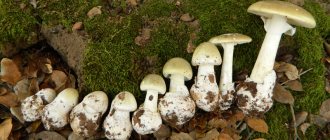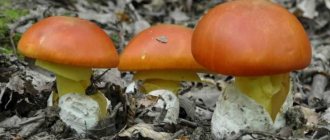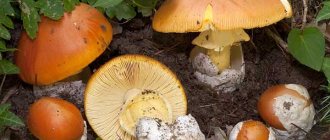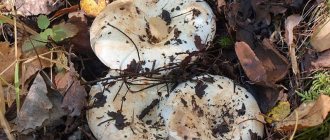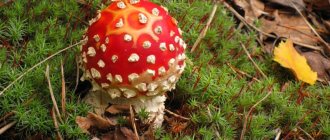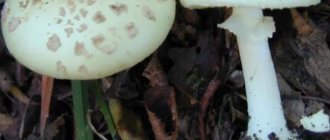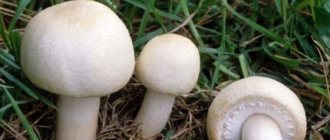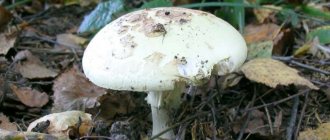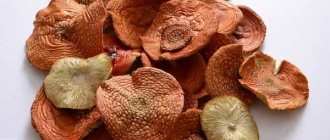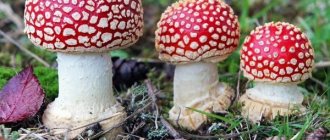The stinking fly agaric is one of the deadly mushrooms in our forests. Even the most ordinary manual contact with it, and then touching the mouth, can cause severe poisoning. It is one of the three most poisonous mushrooms, giving way to the palm in this sad list to the two most dangerous and toxic mushrooms - string and toadstool.
Considering all the potential danger of the stinking fly agaric, every mushroom picker must know this mushroom and be able to recognize it among a large number of similar species.
Description of the mushroom
The stinking fly agaric is also known to mushroom pickers as white toadstool (From the Latin Amanita virosa). It's white, not pale. Although they are close relatives, there are a number of significant differences between them.
The English name of the mushroom “destroying angel” is translated as “destroying angel” - a self-explanatory name that does not require explanation.
The stinking fly agaric is easy to spot in the forest - all parts of the mushroom are pure white in color, which makes it noticeable against the background of green moss or fallen leaves. Only with age can the mushroom acquire a slight creamy or yellowish tint.
hat
The cap is usually 5–9 cm in diameter, sometimes specimens up to 16 cm in diameter are found. Initially it has an elongated bell-shaped shape, but as it grows it becomes flatter. A mandatory distinctive feature of this fly agaric is the presence of a prominent crown on the cap. Unlike other types of fly agarics, the stinking fly agaric does not have remnants of a common cover on its cap - the so-called spots. It is smooth, shiny, and slightly sticky when wet.
Records
The plates of the mushroom are often located and free. Their white color is another important feature by which the white grebe can be easily identified. If the plates are painted, then you can be completely sure that it is not a stinking fly agaric.
Leg
The stalk is white, up to 12 cm long, up to 1.5 cm in diameter. Slender or slightly curved, with a pronounced tuberous expansion at the base of the mushroom. The surface of the stalk is coarsely fibrous, covered with downward-pointing scales.
On the stem, as a rule, there is a white, uneven ring, sometimes attached to the cap. But there are specimens of mushrooms on which the ring completely disappears. Therefore, the widespread belief that the white grebe always has a ring on its leg is not true and can lead to an irreparable error.
At a very young age, the white grebe is hidden under a common blanket and has an ovoid shape. As it grows, this veil breaks and becomes a sac-like thickening of the stalk at the base of the mushroom - a volva. It is not always noticeable because it can be buried in the soil.
Pulp
The flesh of the stinking fly agaric is white and does not change color when cut. It has a faint unpleasant odor, vaguely reminiscent of the smell of rotten potatoes.
Common spring line
Common spring string grows in Russian forests in the early period. You can meet it on forest edges, in freshly cleared areas and on roadsides.
The appearance of the spring stitch cap is a folded and wrinkled cap with different shades of brown flowers. With age, the color of the cap becomes richer. The mushroom gives off a mushroom smell with an admixture of almond smell. The line looks like a morel. They can be distinguished only by the shape of the cap. The morel cap has a regular egg shape.
Signs of mushroom poisoning can be either immediate or delayed. The nervous system is affected by the poison.
Where does the white toadstool grow?
White grebes love soil with sufficient moisture, moderate warmth and shade. They prefer coniferous forests with spruce and deciduous forests with alder, oak, and birch. They also grow in mixed forests. These fly agarics like places with a developed moss cover.
Found from early July to late September. In the first half of the season they appear more often in young forests, and closer to autumn - in old ones. They can grow in groups or singly. The stinking fly agaric is widespread in the northern temperate zone.
An interesting article - Svinushka - was previously conditionally edible, but is now classified as poisonous.
Mountain gossamer
The mountain cobweb was initially considered edible, only after a whole complex of deadly toxins, in the amount of 10 pieces, was discovered in it, the mushroom was classified as poisonous. The toxins present in the mountain spiderwort do not disintegrate during heat treatment and drying.
The nephrotoxic effects of the toxins can be seen within days or weeks, and death occurs within a week or several months after consumption.
Mountain spiderwort grows in ordinary forests, where you can most often find oak, birch, and beech. Mushroom pickers in Western and Eastern Europe, North America and Russia should be wary of encountering it in the fall, from August to November.
The pulp of the cobweb is yellow-brown in color and has a radish smell.
How to distinguish the stinking fly agaric from similar mushrooms?
Similar inedible species and how to distinguish them from them?
- The spring fly agaric (lat. Amanita verna) has a flatter cap and grows in regions with warmer climates.
- The pale grebe (lat. Amanita phalloides) is similar to the white grebe in almost all external features. The only exception is the hat. In the pale grebe it is slightly greenish.
- Amanita ovoidea (lat. Amanita ovoidea). Its distinctive features are a larger volva than that of the stinking fly agaric, as well as a small cream-colored ring on the stem.
Similar edible species and how to distinguish them from them?
- The white float (lat. Amanita alba) looks very similar to the stinking fly agaric, but has a ribbed edge of the cap and is practically odorless.
- Volvariella mucocephala (lat. Volvariella gloiocephala) has pinkish-colored plates and is odorless.
- Champignon (lat. Agaricus) differs from white toadstool by brownish plates and a yellowish ring. If you touch a champignon cap, it will turn yellow.
- The white umbrella mushroom (lat. Macrolepiota excoriata) has a harder fibrous stem and does not have an unpleasant odor.
Advice! Do not cut the mushroom right down to the cap, so that the signs characteristic of the stinking fly agaric do not disappear.
The talker is whitish
The whitish talker is very similar to the edible types of talkers. When it is salted, the poison is not destroyed, but becomes more aggressive and penetrates the structures of other mushrooms.
It grows in places where edible mushrooms grow. It is most optimal to isolate the whitish talker directly when cutting, since in edible talkers a thick milky liquid is formed at the cut sites, and the inedible specimen does not secrete such liquid.
The color of the whitish talker's cap can be either white or with a grayish tint. Rainy weather helps cover the mushroom cap with a coating of mucous content with adhesive properties.
White toadstool poisoning: symptoms
White toadstool poisoning in some cases is similar in its manifestations to the symptoms of ordinary food poisoning. But in terms of severity, mushroom intoxication is the most dangerous to human life.
Important! If at least one white toadstool gets into the basket with edible mushrooms, all mushrooms cannot be eaten!
Symptoms of stinking fly agaric poisoning do not appear immediately - 8–24 hours after ingesting the poisonous mushroom. Unfortunately, by this time, serious damage has already been caused to the victim’s body - the poison causes significant destruction of the liver and disrupts the functioning of the kidneys.
The patient experiences nausea, vomiting, sharp abdominal pain, thirst, general weakness, and severe salivation. In particularly severe cases, convulsions, delirium, hallucinations, diarrhea, tachycardia and ultimately coma occur.
The period of so-called false improvement in the patient’s condition is very dangerous - on the second or third day the victim becomes noticeably better, but real recovery does not occur and the disease progresses.
The likelihood of death from white toadstool poisoning is very high.
Even for a healthy young person who does not suffer from chronic diseases, the poison of the stinking fly agaric is life-threatening. It’s even worse if the poisoned person has cardiovascular pathologies - saving the patient in such a situation is much more difficult.
It remains a very sad fact that the most common poisonings by the stinking fly agaric are observed among children.
How to help with poisoning?
In case of poisoning by white grebes, it is extremely important to provide assistance to the patient as quickly as possible. Even if the symptoms of poisoning are minor at first, you should immediately call an ambulance.
Before her arrival, you should clear your stomach: drink 2 liters of water and induce vomiting. It is necessary to take activated carbon at the rate of 1 gram per 1 kilogram of weight.
The sooner the patient is taken to the hospital, where he will receive antitoxic therapy, the more favorable the prognosis for recovery will be.
Folk remedies for white toadstool poisoning
- Protein water is used to provide first aid. Beat 3 egg whites in 1 liter of water and give the mixture to the patient. Drink often, in small portions. This slows down the absorption of toxic substances into the blood. Instead of water, you can use milk or whey.
- In oriental medicine, the most popular remedy for mushroom intoxication is potato juice.
- Dill decoction with the addition of honey is also used in folk medicine for mushroom poisoning (1 tablespoon of seeds per 1 glass of water).
Important! It should be remembered that all of the above remedies are only suitable for providing first emergency aid. A person who has been poisoned by white toadstools should be taken to the hospital as quickly as possible!
Patouillard fiberglass
Fiberwort is a poisonous and hallucinogenic mushroom. Patouillard fiber contains the largest amount of toxins. It grows in places where edible mushrooms grow at the same time as them. It received the popular name “reddening fiber” because of the ability of the plates to turn from white to red when damaged.
The most optimal growth of this fungus is observed from the end of summer to autumn. It can be found in forests of mixed types, deciduous and coniferous. Very similar to ringed caps and champignons.
Signs of reddening fiber poisoning include narrow pupils, slow pulse, and upset stomach.
Literature
- Grunert G.
Mushrooms / trans. with him. - M.: “Astrel”, “AST”, 2001. - P. 18. - (Guide to nature). — ISBN 5-17-006175-7. - Lesso T.
Mushrooms, key / trans. from English L. V. Garibova, S. N. Lekomtseva. - M.: “Astrel”, “AST”, 2003. - P. 150. - ISBN 5-17-020333-0. - Reference guide: Mushrooms / Answer. for the release of Yu. G. Khatskevich. - Mn.: “Harvest”, 2002. - P. 292. - 7000 copies. — ISBN 985-13-0913-3.
- Udu J.
Mushrooms. Encyclopedia = Le grand livre des Champignons / trans. from fr. - M.: “Astrel”, “AST”, 2003. - P. 23. - ISBN 5-271-05827-1. - Serzhanina G.I.
Hat mushrooms of Belarus. - Minsk: Science and Technology, 1984.
For what reasons are many people drawn to eat fly agaric?
Collection of fly agaric mushrooms.
Is it worth it? People still learn from their mistakes and have already learned not to eat this dangerous forest inhabitant without objective reasons for this. But our brain is designed in such a way that we want to try this beautiful specimen. But we often still ask the question: “what will happen?” and “is it fatal?”
- Yes, fatal. But death from eating the most famous one, the red fly agaric, rarely occurs. You need a large dose of consumption and a weak body. But just like that, you shouldn’t indulge in consuming this beauty. It contains substances that cause brain cells to die in large numbers and a person gradually loses a clear mind and loses adequacy in his actions.
In rare cases, it happens that a person eats it unknowingly. What to do and what could be the consequences?
One red individual is not able to cause serious harm; a slight change in the state of the body is possible. It’s better to play it safe and rinse your stomach to accurately minimize the toxic effect on the human brain.
Experts do not have a clear opinion on the lethal dose, but various sources claim that ten fly agaric hats can have a detrimental effect. The figure is still under discussion and cannot be given an exact number, but I can say with confidence that even one hat should not be used just like that.
The villain in children's fairy tales?
Fly agaric in folk tales
Since childhood, we are taught and shown in fairy tales that the mushroom is evil, bad and an enemy to the human body. Children from an early age associate the evil Baba Yaga and evil forests with negativity. And rightly so, I think. Fly agaric is truly a very beautiful mushroom. Children are unknowingly drawn to the unknown and beauty. In ancient Rus' they knew how to convey to young children about the toxicity of the mushroom and protect them from bad consequences.
Beautiful boletus
The beautiful boletus is a poisonous mushroom that can cause poisoning, manifested in the form of diarrhea, nausea, vomiting and abdominal pain. Poisoning goes away after a temporary illness; no deaths have been recorded.
A mushroom with dense flesh and a yellow color that turns blue when cut. You can find it among the coniferous trees of stonecarp and grand fir, growing in New Mexico and on the west coast of North America.
What poisonous mushrooms do you know?
09/08/201817/03/2019 TanyaVU 1354
Lepiota brown-red
Lepiota brown-red contains cyanide. It can be found in Western Europe, Central Asia, Ukraine and the southern part of Russia. You should be wary of it from mid-June to August inclusive.
The shape of the cap is flat or convex-spread with drooping edges, creamy or grayish-brown in color with a cherry tint. Fresh mushrooms smell like fruit, while old mushrooms smell like bitter almonds.
It was noted in Central Asia and in the Ukrainian city of Donetsk. It grows in the park, on the lawn and in meadows.
